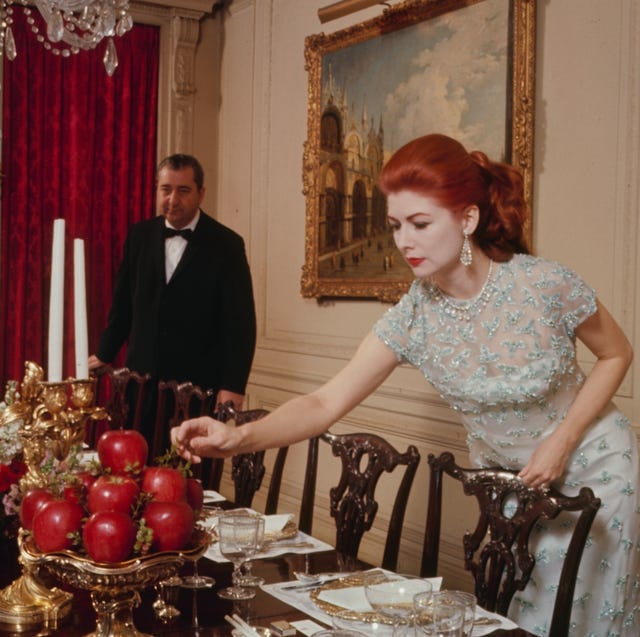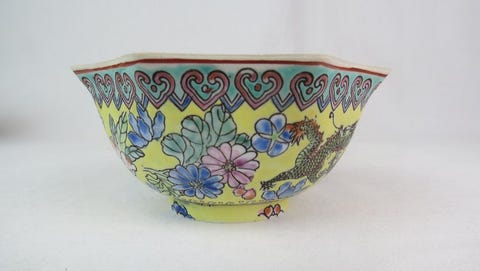What Kinds Of Serving Dishes Do You Register For

Alfred Eisenstaedt
Information technology'southward no undercover that Americans have fabricated dinners at home a more than casual affair over the final several decades, preferring to set the tabular array with breezy dishware near nights and breaking out their fine china only for when celebrating holidays and milestones or when entertaining friends and family—if at all.
Merely with and then many of the states spending more than time at home and eating nearly every meal at our kitchen or dining room tables, it'southward time to inquire ourselves: Who (and what) are we waiting for? Why not set the table with the "good stuff"—from your favorite china patterns and obscure types of silverish cutlery pieces to your best cocktail glasses—more often to make every day feel a little more special?
Porcelain, which was first fabricated using kaolin clay and ground rock, is believed to have been invented in China erstwhile effectually 200 B.C. Since and so, manufacturing porcelain has evolved and modernized over the centuries as information technology became popular across the world. The Portuguese and Dutch were the first to export porcelain from China to Europe during the 16th and 17th centuries; burgeoning need for porcelain triggered Europeans to produce their ain beginning in the 18th century. By the showtime of the 19th century, porcelain was fifty-fifty fabricated in America.
Because it's fired at very high temperatures, porcelain is extremely durable. Add to that long-lastingness a mitt-crafted entreatment and classic decorative motifs, and you have one truly timeless material that's sure to elevate everyday dinners to elegant events. Read on to observe 18 essential types of porcelain serving pieces every political party cupboard ought to take.

ane of 18
Charger Plate
This big decorative plate is typically used every bit a base setting onto which other serving pieces are placed during formal meals. Also known equally a service plate, under plate, or chop plate, a charger plate paves that fashion for elegant multiple-course meals during which each course is served on its own plate or basin and placed on top of the charger.

two of 18
Tureen
Originally used for serving soups or stews, these big, deep covered dishes allow hosts to serve multiple guests at the tabular array in a beautiful, highly decorative piece. Louis XIV, who had a penchant for rich stews, is said to have popularized the utilize of the tureen, which became a symbol of weath in Europe during the 17th and 18th centuries.

iii of xviii
Saucierre
Boat-shaped pitchers, from which sauce or gravy is served, typically sit down on a matching plate to grab drips. This i from the 1900s, past Limoges, features hand-painted fish, a typical motif on vintage and antique sauce boats.

4 of 18
Salt Cellar
Use of table salt cellars— (minor dishes for holding and dispensing salt during a meal) has been documented to s far back every bit classical Rome. Although they were largely replaced by salt shakers in the 20th century, salt cellars with lids and open ones similar this Japanese swan version, remain collectors' items today.

five of 18
Oyster Plate
Like so many other specialized cutlery and serving pieces, oyster plates are a product of the Victorian era, during which oysters were considered a delicacy.
The plates, most of which feature ornate and intricate manus-painted decorations and are intended to serve oysters without their shells, come in three shapes: geometric (like the one shown) with half dozen molds and a well for sauce in the heart; turkey, with five molds that incorporate the shape of a turkey; and kidney-shaped, with five molds that contain the shape of a kidney.

6 of 18
Finger Basin
Another Victorian-era invention, the individual finger bowl was used for rinsing one'southward fingers before the final diner course is served. They largely brutal out of use during Earth War I (when excesses were discouraged); today, finger bowls make for excellent condiment-serving dishes.

7 of 18
Bone Dish
These crescent-shaped plates are used to collect discarded fish bones during a meal. Though they were staples on the Victorian-era table (set to the upper left of the dinner plate), bone dishes are rarely used for that purpose today.

8 of 18
Demitasse Cup and Saucer
These petite-handled cups, showtime used in France in the 1800s, tin hold one-half the liquid of a typical coffee cup and are intended to serve espresso, Turkish coffee, or sometimes hot chocolate.

9 of 18
Cream Soup Bowl
Made for serving cream-based soups, these bowls are generally wider and shallower than other bowls, and they typically characteristic handles on each side. Foam soup bowls may exist tipped using those handles then that every last flake of soup may be consumed.

10 of 18
Covered Vegetable Bowl
Not to be dislocated with a tureen, which is larger, this versatile serving piece can either be circular or oval and boasts a pair of handles. Use information technology to serve sides you'd like to keep warm, from rice or potatoes to roasted or stewed vegetables.

11 of 18
Creamer
Besides known as a milk jug, creamers feature handles and spouts for pouring but can come in many sizes, even within one china pattern. This 19th-century English Imari-style example is two inches tall.

12 of xviii
Sugar Bowl
Used for holding sugar as the name suggests, these minor serving dishes are typically lidded and almost always feature a pair of handles. This Royal Copenhagen case dates from the middle of the 20th century.

13 of eighteen
Tea Pot
Tea, which originated in Communist china some six,000 years agone, made its way to England in the 17th century, where it became the national drink and is now a daily ritual. The British public took their tea from Chinese-fabricated pots like this i well into the 18th century, when the English language porcelain manufactory took off in earnest.

14 of 18
Java Pot
In comparison to tea pots, coffee pots are taller and more slender, with a smaller spout. Java, which made its fashion from the Arabian penninsula to Europe in the 17th century, did non become the preferred beverage in America until subsequently the Boston Tea Party in 1773, when the colonists revolted against a revenue enhancement on tea imposed by King George III. Americans accept been drinking more java than tea ever since.

15 of 18
Seafood Salad Plate
These scallop vanquish plates make for excellent salad plates, shellfish class plates, or even dessert plates. Prepare them atop dinner plates for a sculptural table.

16 of eighteen
Oval Serving Platter
Also known as meat platters, these versatile serving dishes range in size from 10 inches long upwardly to nineteen inches long. This Doulton example, which was made in England earlier 1900, measures 14 inches long. Use oval serving platters on the dinner table to serve master courses—or on a console tabular array to coral collectibles.

17 of eighteen
Round Vegetable Bowl
Also called salad bowls or serving bowls, round vegetable bowls—either rimmed or coup (without rims)—range in size from 8 to ten inches across and are used for serving salads, pastas, or other side dishes that do non demand to be kept warm with a lid.

eighteen of eighteen
Knife Balance
Occasionally referred to equally pocketknife benches, these pieces were developed in the 17th and 18th centuries to go on utensils from staining tabular array cloths. During the 19th century, when knives began to be designed weighted toward their handles, pocketknife rests were no longer necessary for protecting tablecloths. Today, they are mostly purchased as collector's items.
What Kinds Of Serving Dishes Do You Register For,
Source: https://www.veranda.com/luxury-lifestyle/g32647281/types-of-serving-dishes/
Posted by: bowenhimighar.blogspot.com


0 Response to "What Kinds Of Serving Dishes Do You Register For"
Post a Comment